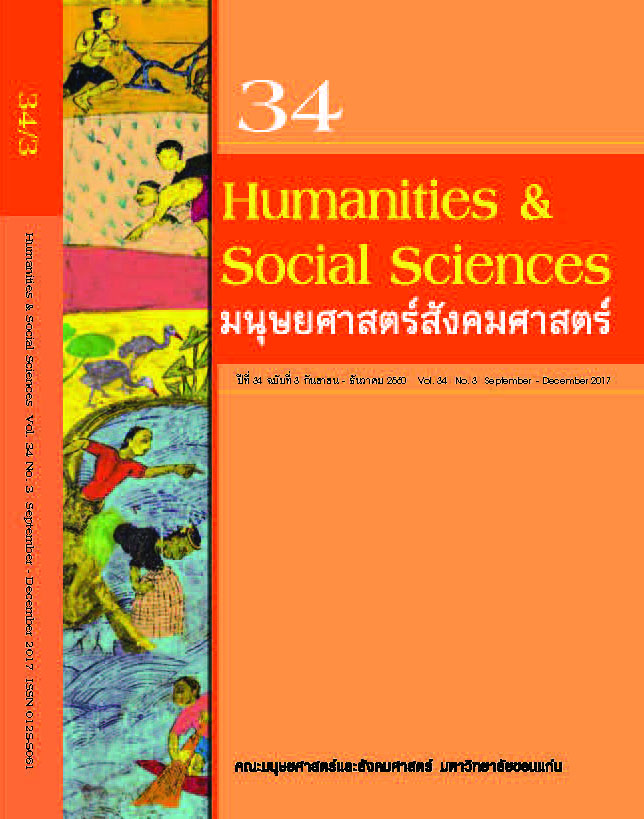การแปรของหน้าที่ของดัชนีปริเฉท “you know” ที่ใช้ในผู้พูดชาวอังกฤษ จากคลังข้อมูลภาษาอังกฤษแห่งสหราชอาณาจักร (BNC)
Keywords:
ดัชนีปริเฉท, คลังข้อมูลภาษาอังกฤษแห่งสหราชอาณาจักร, การแปรภาษา, เพศ, pragmatic expression, BNC, linguistic variation, genderAbstract
บทคัดย่อ
ในการใช้ภาษาอังกฤษแบบอังกฤษในการสนทนาทั่วไป “you know” จัดว่าเป็นดัชนีปริจเฉทที่มีความกำกวมว่าควรจะมีหน้าที่อะไรในการวิเคราะห์ข้อความ ไบเบอร์และคณะ (1999) เลคอฟ (1973) ให้ความเห็นว่า “you know” มักใช้ในเพศหญิง เนื่องจากเพศหญิงอาจจะมีความอ่อนไหวและไม่มั่นคงเกี่ยวกับการใช้ภาษามากกว่าเพศชาย ในประเด็นเรื่องหน้าที่ “you know” ส่งสัญญาณให้กับผู้ฟังทราบว่า ผู้พูดได้ตระหนักว่า ผู้ฟังน่าจะมีความรู้ หรือ ประสบการณ์ที่อ้างถึงร่วมกันแม้ว่าผู้ฟังจะทราบมาก่อนหรือไม่ก็ตาม อนึ่ง สิ่งนี้แสดงให้เห็นถึงความไม่มั่นใจในการให้ข้อมูลแก่ผู้ฟังเช่นกัน มีนักภาษาศาสตร์จำนวนมากได้วิเคราะห์หน้าที่ของดัชนีปริเฉทดังกล่าว อาทิเช่น เลคอฟ (1973), โฮล์ม (1986), ชริฟฟิน (1987, rev. 2012), โรเมน และ แลง (1991), เออร์เมน (1992) ผู้วิจัยเห็นว่าแนวทางการวิเคราะห์หน้าที่ของดัชนีปริจเฉทของเออร์แมน (1992) มีความครอบคลุมและน่าจะอธิบายพฤติกรรมการใช้ภาษาในภาษาอังกฤษแบบอังกฤษได้ดีที่สุด
ดังนั้นงานวิจัยนี้มุ่งเน้นการวิเคราะห์หน้าที่ของปริเฉท “you know” โดยอาศัยแนวการวิเคราะห์ของเออร์แมน (1992) จากคลังข้อมูลภาษาอังกฤษแห่ง สหราชอาณาจักร (BNC) โดยมีการสร้างคลังข้อมูลขนาดเล็กขึ้นใหม่เพื่อให้สอดคล้องกับการวิเคราะห์ การศึกษานี้วิเคราะห์การแปรของหน้าที่ของดัชนีปริเฉท “you know” และการแปรของหน้าที่ของดัชนีปริจเฉทนี้กับตัวแปรทางสังคม ได้แก่ เพศ และ อายุของผู้พูด จากการวิจัยพบว่า ผู้พูดที่มีเพศต่างกันมีแนวโน้มในการใช้ดัชนีปริเฉทดังกล่าวที่แตกต่างกันอย่างมาก ในด้านตัวแปรอายุพบว่า ผู้พูดสูงวัย และกลุ่มวัยรุ่นใช้ดัชนีปริเฉทในลักษณะที่ตรงข้ามกัน นอกจากนี้ยังพบว่า งานวิจัยชิ้นนี้และงานวิจัยของเออร์เมนคล้ายคลึงกันในประเด็นเกี่ยวกับผู้พูดเพศหญิง โดยสรุปแล้ว อาจตีความได้ว่า ผู้ฟังไม่ควรเหมารวมการใช้ดัชนีปริเฉทของผู้หญิงว่ามีหน้าที่เพียงอย่างใดอย่างหนึ่ง หรือ เป็นการใช้ภาษาที่ด้อยกว่าผู้ชาย ผู้หญิงมีแนวโน้มการใช้ดัชนีปริเฉทเพื่อบ่งชี้หน้าที่ต่างๆ ในบทสนทนา ได้ค่อนข้างครอบคลุม และมีการกระจายตามหน้าที่ได้ดีกว่า ผู้ชายมีแนวโน้มการใช้ดัชนีปริเฉทเพื่อบ่งชี้หน้าที่ได้จำกัดกว่าซึ่งไม่ได้สอดคล้องกันกับผู้หญิงมากนัก
Abstract
In British English vernacular, “you know” can be regarded as a pragmatic expression (PE) (Biber. et. al, 1999) containing controversial functions in conversation. Lakoff (1973) suggests that it is more frequently used by linguistically insecure females (Labov, 2001) rather than by males. In terms of function, this filler is to some extent interpretable as a signal and reassurance for the hearers to share experiences, whether they know it or not. It reveals that the speakers are insecure by showing hesitation to their interlocutors. Lately, the study of PE has caught the attention of several linguists (Lakoff, 1973; Holmes, 1986; Schiffrin, 1987 rev. 2012; Romaine & Lange, 1991; Erman, 1992). The analytical approach to PE function, invented by Erman (1992), appears to be the most interesting due to its explanatory power and validity for PE function analysis, thus shedding light on how English native speakers use PE.
Therefore, this study aims at analysing the functions of the PE “you know” in the British National Corpus (BNC) by adopting Erman’s approach. From a sociolinguistic point of view, the gender difference and the age of speakers pertaining to the use of PE was investigated. The study indicates that men and women exhibit quite a clear trend of using this marker differently. The elderly and adolescents show a reverse trend of PE function usage. It was found that there was a similarity with regard to the issue of gender between this current study and Erman’s (1992) study. To conclude, it can be implied that female speech should not be stereotyped or seen as inferior to that of males. The distributions of the functions of “you know” in female speakers are better than in males, with male scores being relatively skewed. Therefore, the functions of “you know” in males do not correspond to female usage and practice.



